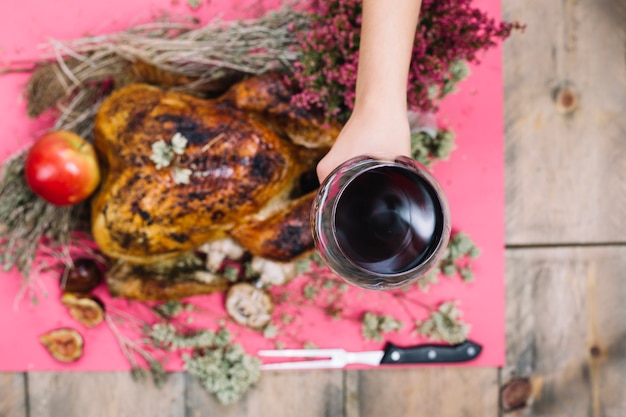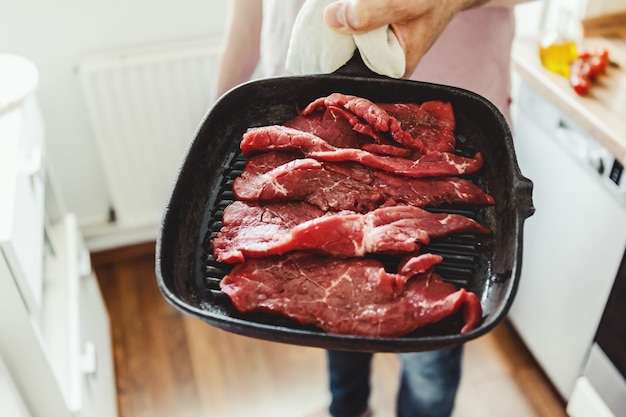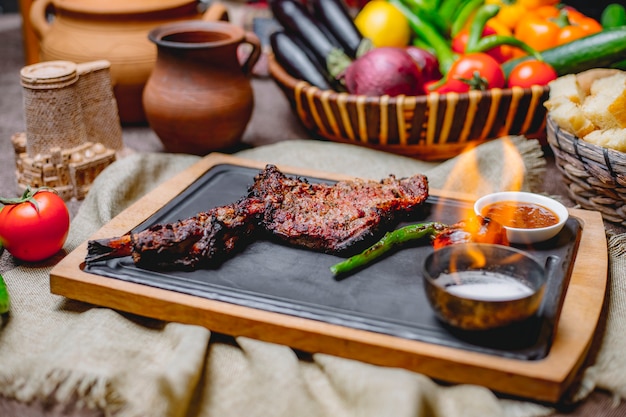(Part 1) Understanding the Basics

choosing the right cut
The first step in creating a perfect roast beef is selecting the right cut. Not all cuts are created equal, and some are better suited for roasting than others.For a truly special occasion, I always opt for rib roast. This cut is incredibly flavorful, boasting a good amount of marbling, and yields a beautiful, even roast that's perfect for carving. It's a bit more expensive, but it's well worth the splurge.
A more affordable alternative is sirloin roast. While slightly leaner than rib roast, sirloin still delivers a tender and flavorful roast. It's important to cook it slightly longer to ensure juiciness.
If you're looking for a budget-friendly option, top round roast is a great choice for weeknight dinners. It's a bit tougher than rib or sirloin, but it's still delicious when cooked properly.
Cooking Temperatures and Doneness
Understanding the different cooking temperatures and what they mean for the doneness of your roast is crucial. Here's a quick guide to the most common levels of doneness:A good rule of thumb is to use a meat thermometer to ensure the roast is cooked to your desired level of doneness.
- Rare: 125°F (52°C) – Red center, juicy and tender, best for cuts like rib roast.
- Medium-Rare: 130-135°F (54-57°C) – Pink center, tender and flavorful, a popular choice for many cuts.
- Medium: 140-145°F (60-63°C) – Slightly pink center, slightly firmer texture, suitable for both lean and marbled cuts.
- Medium-Well: 150-155°F (65-68°C) – Minimal pink center, firmer texture, a good option for tougher cuts.
- Well-Done: 160°F (71°C) – No pink center, firm and dry texture, generally used for ground beef or cuts that are less tender.
It's important to note that cooking temperatures and times can vary depending on the size and thickness of your roast. A larger roast will take longer to cook than a smaller one.
(Part 2) Mastering the Roast

Seasoning and Brining
Seasoning and brining play a crucial role in achieving a flavorful and juicy roast beef.My go-to seasoning blend is a simple combination of salt, pepper, garlic powder, and onion powder. I also like to add a touch of paprika for a bit of color and depth of flavor. A pinch of cayenne pepper can add a subtle kick.
Brining is a game-changer for roast beef. It infuses moisture and flavor into the meat, resulting in a more tender and succulent roast. A simple salt water solution is effective, but you can also experiment with flavored brines that include herbs, spices, citrus, and even sugar. For smaller roasts, a few hours of brining can make a noticeable difference. For larger roasts, I recommend brining overnight.
Searing
Searing your roast before roasting is a technique that adds flavor and creates a delicious crust.Heat a large skillet over high heat and add a generous amount of oil. Sear the roast on all sides for about 2-3 minutes per side, or until nicely browned. The process not only adds flavor but also helps create a barrier that prevents moisture from escaping during the roasting process.
(Part 3) roasting techniques

oven roasting
Oven roasting is the most common and straightforward method for cooking a roast beef. It's a classic approach that delivers consistent results.Preheat your oven to 450°F (232°C) and place the seasoned roast on a roasting rack in a roasting pan. The rack allows for air circulation, ensuring even cooking. Let the roast cook for 15 minutes, then reduce the oven temperature to 325°F (163°C). Continue roasting until the roast reaches your desired level of doneness. This method creates a beautifully crispy crust while ensuring a tender and juicy interior.
slow roasting
Slow roasting is a technique that delivers a melt-in-your-mouth roast beef. The lower temperature allows the meat to cook slowly and evenly, resulting in an incredibly tender and flavorful roast.Preheat your oven to 275°F (135°C) and place the seasoned roast in a roasting pan. For added flavor, you can add some vegetables like carrots, onions, and potatoes to the bottom of the pan. Cook the roast for about 1.5-2 hours per pound, or until it reaches your desired level of doneness.
reverse searing
Reverse searing is a technique that combines the best of both worlds: low and slow cooking for tenderness followed by high-heat searing for a crispy crust.Preheat your oven to 250°F (121°C) and place the seasoned roast in a roasting pan. Cook the roast until the internal temperature is about 10 degrees lower than your desired level of doneness. For example, if you want medium-rare, cook it to 120°F (49°C). Remove the roast from the oven and let it rest for 15 minutes. Then, sear the roast on all sides in a hot skillet until it reaches your desired internal temperature. This method ensures a perfectly tender and juicy roast with a flavorful, crispy crust.
(Part 4) Resting and Carving
Resting
Resting is an essential step in achieving a juicy and flavorful roast.After removing the roast from the oven, let it rest for at least 15-20 minutes before carving. This allows the juices to redistribute throughout the roast, preventing them from spilling out when you slice it. While the roast is resting, you can prepare the gravy.
Carving
Carving the roast properly ensures even slices and maximizes the tenderness of the meat.Use a sharp carving knife and a carving fork to hold the roast steady. Slice the roast against the grain, which means cutting perpendicular to the direction of the muscle fibers. This will make the meat easier to chew and more tender.
(Part 5) Gravy
Making the Gravy
Gravy is the perfect accompaniment to roast beef, adding richness and depth of flavor.To make gravy, you'll need the drippings from the roast, flour, and broth. Once the roast has rested, pour off the excess fat from the roasting pan and deglaze the pan with a small amount of broth. Whisk in a tablespoon or two of flour and bring the mixture to a simmer, stirring constantly. Slowly add more broth until the gravy reaches your desired consistency. You can also add seasonings, like herbs and spices, to the gravy for extra flavor.
Adding Flavor to Gravy
There are countless ways to add flavor to your gravy. Here are a few ideas:
- Add a tablespoon of red wine vinegar for a tangy twist.
- Incorporate chopped herbs like rosemary, thyme, or parsley for a fragrant, aromatic gravy.
- Use beef broth for a richer flavor, or try chicken broth for a lighter option.
- Add a dollop of Dijon mustard for a touch of heat and complexity.
- Finish the gravy with a pat of butter for extra richness and shine.
(Part 6) Accompaniments
Vegetables
Roast beef is best enjoyed with a variety of vegetables.Here are some of my favorite sides for roast beef:
- Roasted Vegetables: Carrots, potatoes, onions, and Brussels sprouts are all excellent choices for roasting alongside the beef. Toss the vegetables with olive oil, salt, pepper, and herbs for a flavorful and healthy side dish.
- mashed potatoes: Creamy, comforting mashed potatoes are a classic pairing for roast beef. Add a little milk, butter, and salt and pepper for a delicious side dish.
- green beans: Steamed or sautéed green beans add a touch of freshness to the meal.
- Asparagus: roasted asparagus spears offer a vibrant and flavorful accompaniment.
- Winter Squash: Roasted butternut squash or acorn squash adds a touch of sweetness and complements the savory roast beef.
Yorkshire Pudding
Yorkshire pudding is a traditional British side dish that pairs perfectly with roast beef.It's made with batter, cooked in a hot pan until puffy and crispy. You can serve it alongside the roast beef, or fill it with gravy and serve it as a main course.
Other Sides
For a more diverse spread, consider these other sides:
- Horseradish Sauce: A classic accompaniment for roast beef, horseradish sauce adds a spicy kick.
- Cranberry Sauce: Sweet and tart cranberry sauce provides a delightful contrast to the savory beef.
- pickled onions: Tangy pickled onions add a refreshing touch to the meal.
- Garlic Bread: A simple yet delicious side, garlic bread is always a welcome addition.
(Part 7) Leftovers
Reheating
If you have leftover roast beef, don't despair! There are many ways to repurpose it into delicious meals.- Oven: Preheat the oven to 325°F (163°C) and place the leftover roast beef in a baking dish. Cover the dish with foil and bake for about 15-20 minutes, or until heated through.
- slow cooker: Place the leftover roast beef in a slow cooker with a small amount of broth or gravy. Cook on low heat for 2-3 hours, or until heated through.
- Skillet: Heat a little olive oil in a skillet over medium heat. Add the leftover roast beef and cook for about 5-7 minutes, or until heated through.
Recipes with Leftovers
Leftover roast beef is a versatile ingredient, perfect for creating a variety of dishes.
- Beef Sandwiches: Slice the leftover roast beef thinly and use it to make delicious sandwiches on crusty bread. Add your favorite toppings, such as cheese, lettuce, tomato, and mustard.
- Beef Soup: Chop up the leftover roast beef and use it to make a hearty beef soup. Add vegetables like carrots, onions, celery, and potatoes.
- Beef Tacos: Shred the leftover roast beef and use it to make tacos with your favorite toppings.
- Beef Salad: Slice the leftover roast beef thinly and toss it into a salad with fresh greens, vegetables, and a tangy dressing.
- Beef Hash: Dice the leftover roast beef and combine it with potatoes, onions, and peppers for a hearty and flavorful hash.
(Part 8) Tips and Tricks
Tips for a Perfect Roast
Here are a few more tips for ensuring a perfect roast every time:
- Don’t overcrowd the pan: If you're cooking a large roast, use two pans instead of cramming everything into one. This will help ensure even cooking and prevent the roast from steaming instead of roasting.
- Avoid pricking the roast: Pricking the roast will cause the juices to escape and result in a dry roast.
- Let the roast rest: As mentioned earlier, resting the roast is crucial for allowing the juices to redistribute, resulting in a more tender and flavorful roast.
- Use a meat thermometer: A meat thermometer is essential for ensuring the roast is cooked to your desired level of doneness.
- Consider a roasting bag: A roasting bag can help to lock in moisture and prevent the roast from drying out.
Troubleshooting
Even the best cooks encounter occasional mishaps. Here are some common problems and solutions:
- Roast is too dry: If your roast is dry, it might have been cooked for too long or at too high a temperature. Try using a lower oven temperature next time and cooking the roast for a shorter period. You can also try adding a little bit of broth or water to the roasting pan to help create steam and keep the roast moist.
- Roast is undercooked: If your roast is undercooked, return it to the oven and continue cooking until it reaches your desired level of doneness.
- Roast is unevenly cooked: If your roast is unevenly cooked, it might have been overcrowded in the pan or not cooked at a consistent temperature. Try using a roasting rack to allow for better air circulation and make sure your oven is preheated to the correct temperature.
FAQs
1. What is the best way to know when a roast beef is done?
The best way to know when a roast is done is to use a meat thermometer. Insert the thermometer into the thickest part of the roast, making sure it’s not touching any bone. The internal temperature should be at your desired level of doneness.
2. Can I cook roast beef in a slow cooker?
Yes, you can cook roast beef in a slow cooker. However, it might not produce the same crispy crust as oven roasting. It’s best to use a cut of beef that’s more tender, like a chuck roast or a pot roast. Cook the roast on low heat for 6-8 hours, or until it's fork-tender.
3. Can I freeze roast beef?
Yes, you can freeze cooked roast beef. Wrap it tightly in plastic wrap and aluminum foil and freeze for up to 3 months. Thaw it in the refrigerator overnight before reheating.
4. How do I prevent my roast beef from drying out?
To prevent your roast beef from drying out, cook it at a lower temperature and for a shorter period. Use a meat thermometer to ensure it reaches your desired level of doneness. You can also try adding a little bit of broth or water to the roasting pan to help create steam and keep the roast moist.
5. What is the best way to serve roast beef?
Roast beef is best served sliced thinly and alongside a variety of sides, like mashed potatoes, roasted vegetables, and Yorkshire pudding. You can also serve it with a delicious gravy.
Remember, the key to a perfect roast beef is understanding the basics, mastering the techniques, and having fun with it. Don't be afraid to experiment and find what works best for you. With a little practice, you'll be serving up mouthwatering roast beef that everyone will rave about!
Everyone is watching

Corn on the Cob: The Ultimate Guide to Perfectly Cooked Ears
Healthy MealsAh, corn on the cob. Just the name evokes images of sunny days, barbecues, and that sweet, juicy flavour that ...

Perfect Pork Roast Oven Cooking Time: A Guide to Delicious Results
Healthy MealsThere's something truly satisfying about a perfectly roasted pork. The aroma alone is enough to make your mout...

Scallops: The Ultimate Guide to Perfect Cooking
Healthy MealsAh, scallops. Those delicate, sweet, and utterly delicious morsels of the sea. They hold a special place in my...

Spaghetti Squash: The Ultimate Guide to Cooking and Serving
Healthy MealsRemember that time you saw spaghetti squash at the supermarket, looking all bumpy and strange, and thought, "W...

Ham Cooking Time: How Long to Bake, Smoke, or Boil a Delicious Ham
Healthy MealsAh, ham. It's a classic, isn't it? A real crowd-pleaser, especially around holidays. And when done right, it'...
